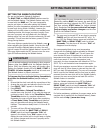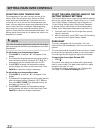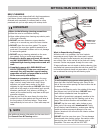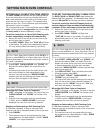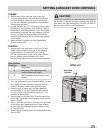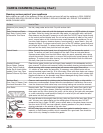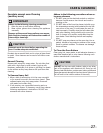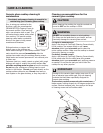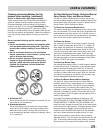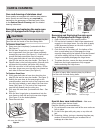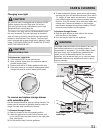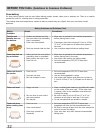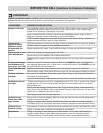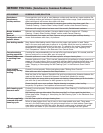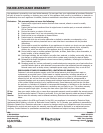
29
CARE & CLEANING
• Aluminum foil
Use of aluminum foil will damage the cooktop. Do not
use under any circumstances.
• Aluminum utensils
Since the melting point of aluminum is much lower
than that of other metals, care must be taken when
aluminum pots or pans are used. Pans that boil dry
may permanently damage cooktop by breaking, fusing
to, or marking it.
Cleaning recommendations for the
ceramic glass cooktop (continued)
Plastic or foods with a high sugar content:
These types of soils need be removed immediately if
spilled or melted onto the ceramic cooktop surface.
Permanent damage (such as pitting of the cooktop
surface) may occur if not removed immediately. After
turning the surface elements OFF, use a razor blade
scraper or a metal spatula with a mitt and scrape the soil
from the hot surface (as illustrated). Allow the cooktop to
cool, and use the same method for heavy or burned on
soils.
Do not use the following on the ceramic glass
cooktop:
• Do not use abrasive cleaners and scouring pads,
such as metal and some nylon pads. They may
scratch the cooktop, making it more difcult to
clean.
• Do not use harsh cleaners, such as chlorine
bleach, ammonia or oven cleaners, as they may
etch or discolor the cooktop.
• Do not use dirty sponges, cloths or paper
towels, as they can leave soil or lint on the
cooktop which can burn and cause Special
Caution for Aluminum Foil and Aluminum
Cooking Utensils
To Clean the Burner Grates, Contoured Burner
Pans, Burner Caps, and Burner Bases.
The burner grates, contoured burner pans, burner cap,
and burner base should be routinely cleaned. Keeping the
burner ports clean will prevent improper ignition and an
uneven ame. Follow instructions below.
To Clean the Contoured Burner Pans
The square burner pans are attached to the cooktop and
are not removable. The burner pan forms a recessed well
area located around each burner unit. If a spill occurs in
one of the four well areas, blot up spill with an absorbent
cloth. Rinse with a clean, damp cloth and wipe dry.
To Clean the Grates
Any remaining soil may be removed by gently scouring
with a soapy scouring pad. Rinse with a 1:1 solution of
clean water and ammonia. If necessary, cover difcult
spots with an ammonia-soaked paper towel for 30 to 40
minutes. Rinse with clean water and a damp cloth, then
scrub with a soap-lled scouring pad. Rinse and wipe
dry with a clean cloth. Remove all cleaners thoroughly or
the grate porcelain may become damaged during future
heating. DO NOT use spray oven cleaners.
To Clean the Burner Caps
Use a soap-lled scouring pad or a mild abrasive cleanser
to clean burner caps. If necessary, cover stubborn spots
with an ammonia-soaked paper towel for 30 minutes.
Rub gently with a soap-lled scouring pad and rinse with
a mixture of clean water and vinegar. Wipe dry. Remove
all cleaners thoroughly or the burner cap porcelain may
become damaged during future heating.
To Clean the Burner Bases and Gas Openings
The ports (or slots) around the burner base must be
routinely cleaned. Use a small-gauge wire or needle to
clean small slots or holes. Use care to prevent damage
to the electrode. If a cleaning cloth should catch the
electrode, it could break or damage the electrode. If the
electrode is damaged or broken, the surface burner will
not light because it will not spark. Manual lighting with a
match is still possible.
For proper ow of gas and ignition of the burner—DO
NOT ALLOW SPILLS, FOOD, CLEANING AGENTS OR ANY
OTHER MATERIAL TO ENTER THE GAS OPENING. Gas
must ow freely through the small hole in the brass orice
for the burners to light properly. If the gas opening orice
becomes soiled or clogged, use a small-gauge wire or
needle to clean. ALWAYS keep the burner cap assembly
and ring in place whenever a surface burner is in use.
After cleaning make sure each burner cap is properly
aligned and level. Turn the burner on to determine if it will
light. If the burner does not light after cleaning, contact a
Service Center. Do not service the sealed burner yourself.



